 TRIZ Paper: Japan TRIZ Symposium 2010 TRIZ Paper: Japan TRIZ Symposium 2010 |

 
|
| Application of USIT to Useful Paper Fastener |
MPUF (Microsoft Project Users Forum) USIT/TRIZ Study Group:
Kouichi Nakamura (USIT/TRIZ Study Member), Noritaka Nakayama (Konica Minolta Technology Center, Inc.),
Hirotake Makino, Hideki Ohmori, Kazushige Aoki (Yokogawa Electric Corp.),
Kazunori Aoki(Tokyo Keiki Kogyo Co.), Etsuo Yamada (USIT/TRIZ Study Member),
Minoru Takimoto (Fuji Xerox Corp.), and Yuji Mihara (Creative Technology Institute Co.) |
The Sixth TRIZ Symposium in Japan,
Held by Japan TRIZ Society on Sept. 9-11, 2010 at Kanagawa Institute of Technology, Atsugi, Kanagawa, Japan |
| Introduction (from "Personal Report of Japan TRIZ Symosium 2010" ) by Toru Nakagawa (OGU), Mar. 21, 2011 |
| Posted: Sept. 25, 2010 |
For going back to Japanese pages, press  buttons.
buttons.
Editor's Note (Toru Nakagawa, Sept. 21, 2011)
This paper was presented last year by Kouichi Nakmura in an Oral session of the 6th TRIZ Symposium in Japan, 2010  . Japan TRIZ Society has posted the presentation slides of this paper, among other contributed papers, in PDF in its Members-only page of the Official Site since last March.
. Japan TRIZ Society has posted the presentation slides of this paper, among other contributed papers, in PDF in its Members-only page of the Official Site since last March.  .
.
For wider circulation of TRIZ papers, I have selected about half of the papers presented at the Japan TRIZ Symposium 2010 and am posting them publicly in this Web site both in English and in Japanese, under the permission of the authors. Nakagawa's introduction/review to each paper was written and posted in "Personal Report of Japan TRIZ Symosium 2010" from November 2010 to April 2011, and is reposted in each page of the paper.
The present page is composed of the followings:
A study group of engineers voluntary coming from different industries worked to develop various concepts for improving simple paper fasteners. They used their 'USIT Workbook' step by step for proving its effectiveness. Processes of analyses and idea generation are recorded fully with a large number of illustrations.
[1] Abstract
Application of USIT to Useful Paper Fastener
MPUF (Microsoft Project Users Forum) USIT/TRIZ Study Group:
Kouichi Nakamura (USIT/TRIZ Study Member),
Noritaka Nakayama (Konica Minolta Technology Center, Inc.),
Hirotake Makino, Hideki Ohmori,
Kazushige Aoki (Yokogawa Electric Corp.),
Kazunori Aoki(Tokyo Keiki Kogyo Co.), Etsuo Yamada (USIT/TRIZ Study Member),
Minoru Takimoto (Fuji Xerox Corp.), and Yuji Mihara (Creative Technology Institute Co.)
The 6th Japan TRIZ Symposium 2010
Held by Japan TRIZ Society on Sept. 9-11, 2010
at Kanagawa Institute of Technology, Atsugi, Kanagawa, Japan
Abstract
MPUF (Microsoft Users Forum) is a NPO aiming at improvement in the quality of Project Management. The number of study groups is launched in about 20, the USIT/TRIZ study group was launched in April,2007.. Members aim at improvement through an event, a seminar, a community, a study group, about various subjects related to project management,The theme introduced this time the achieved result through Working Group activity of a study group.
The following result was able to be achieved by using the technique of USIT in WG to achieve the problem where the paper fastener held the current state.
1. It became easy for the procedure and the thing that had to be done to become clear by using the USIT workbook (Announced from this society last year) and to advance the discussion. And, the USIT template form is used to arrange the result. As a result, it was confirmed for the summary of passage by each STEP of USIT to able to attempt both sharing the result effectively.
2. KeyWord of a wide viewpoint is obtained from this approach, and it introduces the idea of shoes that appear from the KeyWord.
Extended Abstract
In the USIT workbook"Purpose", "Note", "Work procedure", and "Notice point" of each item are first described, and the next case example is described . In actual work we will start by seeing it , the work that we have to do becomes clear. and It came to be able to confirm STEP of work by using USIT template form's
<USIT Work Book example>
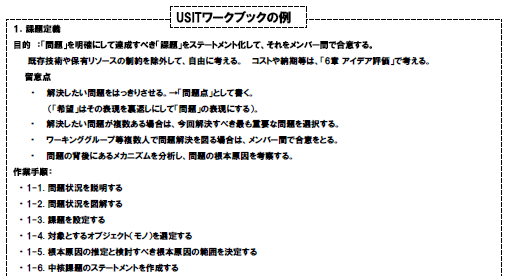
<USIT Template>

<improvement Ideas for paper fastener>
Some of the paper fastener improvement Ideas put out by using the USIT operator is shown below
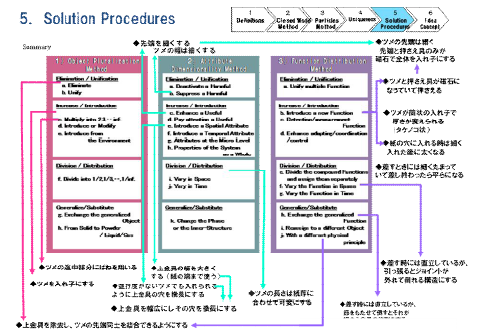
Extended Abstract, PDF in English  in Japanese
in Japanese 
[2] Presentation Slides in PDF
Presentation Slides in English in PDF (32 slides, 1.4 MB) 
Presentation Slides in Japanese in PDF (32 slides, 1.4 MB) 
[3] Introduction by Nakagawa:
Excerpt from:
Personal Report of
The Sixth TRIZ Symposium in Japan, 2010
Part D. Case Studies in Industries
Toru Nakagawa (Osaka Gakuin University)
Mar. 5, 2011 (Posted on Mar. 21, 2011) 
Kouichi Nakamura (*), Noritaka Nakayama (Konica Minolta Technology Center), Hirotake Makino (*), Hideki Ohmori (*), Kazunori Aoki (Tokyo Keiki Kogyo), Etsuo Yamada (*), Osamu Kumasaka (Kumasaka Professional Engineer office), Minoru Takimoto (Fuji Xerox Information Systems Corp.), Tatsuhiko Atsuta (*), and Yuji Mihara (Creative Technology Institute) [(*) MPUF (Microsoft Project Users Forum) USIT/TRIZ Study Group] [J18, O-16] gave an Oral presentation with the title of "Application of USIT to Useful Paper Fastener". In the initial half of the Authors' Abstract, the nature and aim of the group is explained as follows:
MPUF (Microsoft Users Forum) is an NPO aiming at the improvement in the quality of Project Management. The number of study groups launched is about 20, and the USIT/TRIZ study group was launched in April, 2007. Members aim at improving through events, seminars, communities and study groups, about various subjects related to project management. The theme introduced this time is the achieved result through the Working Group activity of the study group.
[*** About the MPUF USIT/TRIZ Study Group, please refer to my explanation in the review of Oral presentation by its another subgroup, H. Kosha et al. ] The latter half of the Authors' Abstract is:
] The latter half of the Authors' Abstract is:
The following result was able to be achieved by using the technique of USIT in the WG to cope with the issues facing the existing paper fasteners.
1. It became easier to advance discussion because the procedure and things to be done become clear by using the USIT workbook (announced from this society last year). And, the USIT template form was used to arrange the results. As a result, it was confirmed that the results could be effectively shared by using the USIT template form to summarize the process of each STEP.
2. Key Words of a wide viewpoint were obtained from this approach, and some ideas generated from these Key Words will be introduced.
As described in the Authors' Abstract, one of the aims of their present work was to follow the steps of the "USIT Workbook" developed in the Study Group and reported a year before by Takuo Maeda et al. The Authors presented their results in detail with 32 slides following the steps. The slide (right), for example, is the description they wrote in the Workbook at the sub-stage [1-(2): Figure of problem situation] in the stage: 1. Problem Definition. The problem was to improve the paper fastener for easier/faster replacement of the papers. To clarify the problem, the slide illustrates the whole process of handling the paper fastener for deleting/inserting several pages. The main difficulty of the process lies at the step (S4) of passing the fingernails through the holes of many pages. |
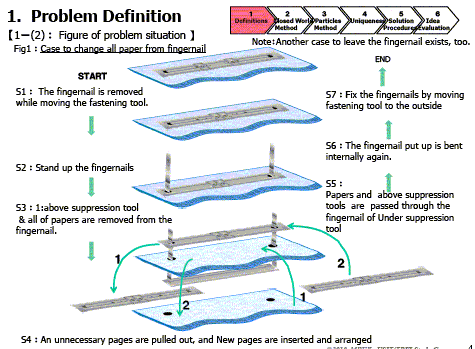 |
The USIT Process (in this Workbook) has 6 stages:
1. Problem Definition,
2. Closed World Method (for analyzing the present system in terms of Objects-Attributes-Functions),
3. Particles Method (for making image of ideal system),
4. Uniqueness Method (for analyzing the problem in terms of Space and Time),
5. Solution Generation, and
6. Idea Evaluation.
The slide (right) shows the initial steps of the Particles Method. Problem situation and corresponding ideal image are sketched, and then the Particles (i.e., imaginary magical substance or Field) are shown with Star marks at the places where the two sketches are different. We imagine that the Particles have some magical capability of achieving the ideal results, and try to understand how they could achieve them. |
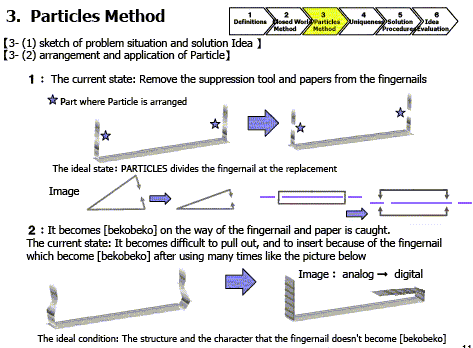 |
The slide (right) shows the latter half of the stage of the Particles Method. Now the Authors construct the Action & Property Diagram (or "AND/OR Tree" according to Sickafus' original naming). The ideal (or most desirable) solution to be achieve is written at the top of the tree diagram. Then desirable partial solutions (which the Particles can achieve in a magical manner) are written step by step downward in the tree structure. The lower branches need to be combined with either AND or OR relationship to achieve the upper node. In the bottom half of the Action& Property Diagram, desirable possible properties are listed up. By using this method the Authors have obtained various suggestions to ideas/solutions. |
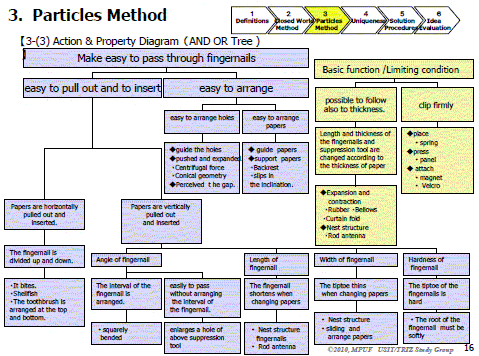 |
USIT has a system of Operators for generating solution ideas. The main 5 USIT Operators are: Pluralizing Objects, Dimensional Change in Attributes, Redistribution of Functions, Generalization of Solutions, and Combination of Solutions. They contain 32 sub-operators in total.
The slide (right) shows a summary of ideas which are generated in the analysis stages and in the solution generation stage by using various USIT Operators. They are classified here in terms of their intentions. The Authors have generated a large number of ideas.
|
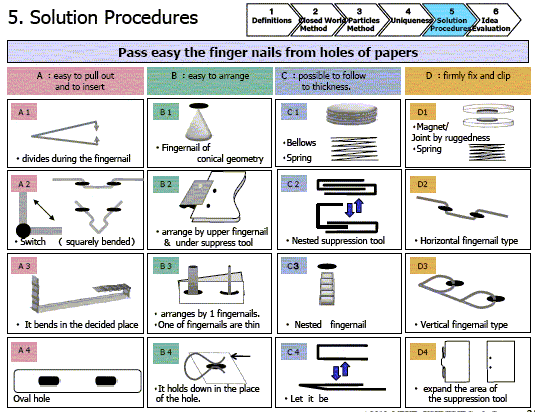 |
Then the Authors have tried to combine various ideas into feasible solution concepts. The following 4 slides demonstrate how the ideas are combined into solution concepts.
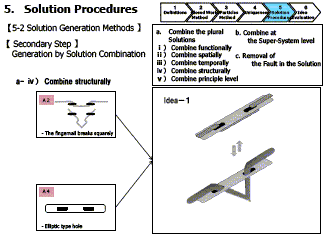
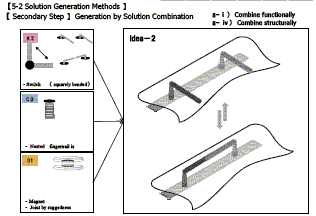
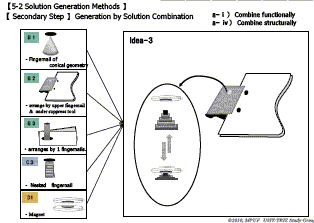
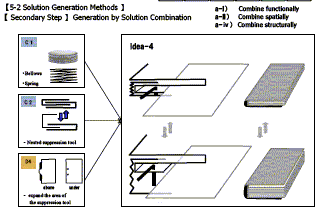
The Authors gives their summary as shown in the slide (right). They have demonstrated the whole process of USIT along their "USIT Workbook" as the template. Since they used a familiar item, a Paper Fastener, the Authors' presentation is easy to follow and good as a case study. They have generated many ideas and their way of thinking can be traced in the presentation. In this sense, the "USIT Workbook" has been shown effective.
[*** Even though the Authors have generated many ideas and demonstrated four solution concepts, I am not satisfied in the effectiveness and feasibility of their solution concepts. In the USIT/TRIZ Study Group I suggested them that the main difficulty in using the current Paper Fastener is arranging/keeping many pages of paper in a neatly-stacked position in the process of passing the two fingernails through the paper holes. Thus my suggestion was to make a complementary device for arranging and keeping the pages in a neatly-stacked way and to use some cloth-like material with "magic tapes" at the ends for fastening them together.] |
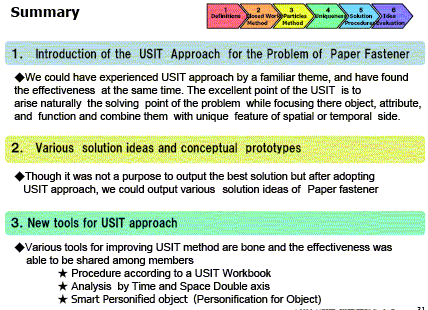 |
Last updated on Sept. 25, 2011. Access point: Editor: nakagawa@ogu.ac.jp

